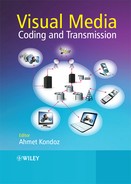11.7 Conclusions
This chapter has presented comprehensive state-of-the-art discussions on various technologies and trends that are being studied and used to develop context-aware content adaptation systems. Apart from a few references included and standardization-related efforts described, it has been noted that there is not much work published on adaptation decision implementations. Nevertheless, a thorough analysis of the different elements and factors that drive the adaptation decision process has been made, as well as an investigation of the current trends in how to use those elements, notably the low-level contextual information. There is a clear trend in merging the high-level semantic world with the adaptation decision process. Major research efforts point to the use of ontologies and Semantic Web technologies to accomplish that goal. The aim is to be able to use automatically-generated low-level contextual information to infer higher-level concepts that better describe real-world situations.
Subsequently, several aspects related to gathering requirements in terms of contextual information, forms of representing and exchanging it, and identification of entities/mechanisms involved in the processing of contextual information, together with the management of digital rights and provision for authorization to the adaptation of media contents, have been presented with a view to a defined application scenario. A number of resource adaptation algorithms have been described, which would operate in harmony with the decision and authorization operations so as to maximize users' experiences. It has been shown that adaptation decision-taking operations can greatly benefit from the use of ontologies for deciding the best available resource adaptation method for the context of the usage environment.
In line with the aforementioned discussions, the concepts and architecture of a scalable platform for context-aware content adaptation have also been described in this chapter; these are especially suited for virtual collaboration applications. The discussions have particularly focused on providing a consolidated view on the current research panorama in the area of context-aware adaptation and the identification of directions to follow. In particular, a number of relevant topics have been presented to identify real-world situations that would benefit from the use of context and of adaptation operations; to identify relevant contextual information; to formulate approaches to specify context profiles; to address DRM during adaptation; and to identify functionalities to build generic context-aware content adaptation systems. Furthermore, the interfaces between the modules of the content adaptation platform and the sequence of events that take place while performing DRM-based adaptation for a particular user or group of users in specific situations have also been presented.
The innovative character of the adaptation platform under consideration has been brought out by addressing different aspects concerning the delivery of networked multimedia content simultaneously. This has been highlighted in the platform by combining the use of ontologies and low-level context to drive the adaptation decision process, verifying and enforcing usage rights within the adaptation operations, incorporating multi-faceted AEs, and being able to deliver on-the-fly, on-demand, different adaptation operations that suit different dynamic requirements. It is envisaged that the definition of such a modular architecture with well-defined and standards-based interfaces will greatly contribute to the interoperability and scalability of future content delivery systems.
